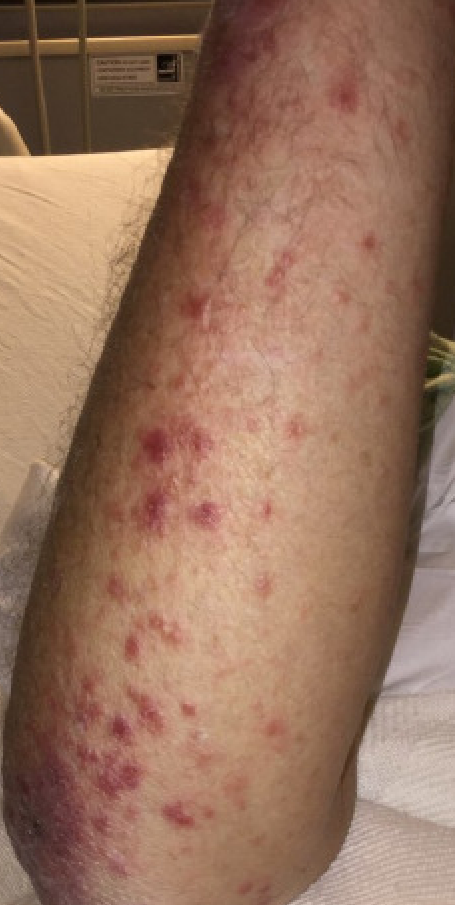Case Presentation: A 63-year-old man with history of coronary artery disease and ulcerative colitis (treated with azathioprine and prednisone for the past 4 weeks) presented with complaint of fevers, bloody diarrhea, and progressive rash of 3 weeks duration. He had been admitted to an outside hospital where he was found to be borderline hypotensive with leukocytosis, anemia, and elevated procalcitonin. He was started on broad spectrum antibiotics and fluids. Rash continued to spread to his trunk, back, and right leg. Blood and urine cultures, acid-fast bacilli smear, echocardiogram, CT abdomen/pelvis, and chest radiography were unrevealing for infectious causes. Patient was subsequently transferred for further evaluation, where exam revealed non-blanching red to dark infiltrative dermal papules with rare pustules. Azathioprine was held while patient was continued on low dose steroids and ceftriaxone for 8 days. Dermatology was consulted and skin biopsy revealed early phase leukocytoclastic vasculitis. Based on history, he was diagnosed with azathioprine hypersensitivity syndrome (AHS). Symptoms began to improve with avoidance of azathioprine. On discharge, patient was instructed to discontinue azathioprine and follow up with his gastroenterologist to monitor for resolution and determine a new medication regimen for ulcerative colitis.
Discussion: Azathioprine is an immunosuppressant used to treat a variety of autoimmune conditions such as inflammatory bowel disease, lupus, and multiple sclerosis. Adverse reactions occur in about 20% of patients, most commonly within the first month of therapy. While typical symptoms are gastrointestinal in nature, 2% of patients will be diagnosed with AHS. AHS is characterized by acute fever, arthralgia, abdominal pain, nausea, and cutaneous eruptions but can also present with hypotension and end organ dysfunction mimicking sepsis. The exact etiology of AHS is unknown; however, the current hypothesis is a type III/IV immune mediated reaction related to the imidazole component. Those presenting with AHS will have leukocytosis, neutrophilia, anemia, elevated inflammatory markers, positive antineutrophil cytoplasmic antibodies, and skin biopsy showing neutrophilic dermatosis. AHS resolves spontaneously within 7 days of azathioprine cessation. In those with suspected AHS, it is important to clearly document azathioprine as a drug allergy in the medical chart and avoid the medication completely as re-challenge can lead to anaphylaxis, shock, and circulatory collapse.
Conclusions: Azathioprine hypersensitivity syndrome is rare and often underdiagnosed adverse reaction to a common immunosuppressant. Timing of symptoms, a thorough drug history, and subsequent drug cessation are key to diagnosis and management of this syndrome.

